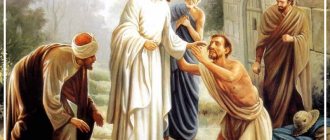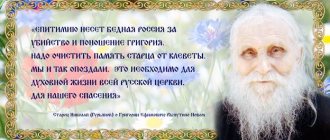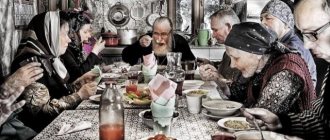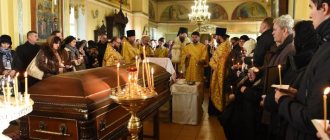What is holiness
Modern theological encyclopedias call it “one of the fundamental concepts of Christian teaching ,” although the Gospel speaks of the holiness of God, His Son Jesus, and finally the Spirit, the Third Person of the Holy Trinity. But not people. But the disciples of Christ talk a lot about this - already after the birth of the Church.
Definition
The content of the concept is not the same among Jews and Christians.
"Holy" or "righteous"?
The Slavic "holiness", the Greek "αγιότητα" ( "hagiotita ") or "ιερότητα" ( "hierotita ") are all almost literal translations of the Hebrew word "kadosh", which applies only to God, the Divine, or that which is dedicated to Him ( for example, sacrifices, temples, liturgical vessels). “ Kadosh ” means separation from the human world, separation from it.
For this reason alone, a Jew would never use this word to designate a person, although God Himself speaks more than once about holiness as the task of believers:
"Be Holy For I Am Holy"
(Lev.1:44).
But still, for a person who was especially close to God, the concept of “righteous person” . The way to achieve perfection was to fulfill the Law (and it contains more than 600 commandments, from moral ones to those related to worship, lifestyle, food, clothing, and housing).
Therefore, the Jewish righteous man, the one who knows, observes what the prophet commanded. Moses . So the Jews were not embarrassed to call St. “righteous.” James, the brother of the Lord, the first bishop of Jerusalem, but they were extremely shocked by the violation of the Sabbath by Christ, and especially by the words and actions of St. Paul, “a Pharisee, the son of a Pharisee,” who openly said that he considered everything (and many prohibitions imposed on the believer by the Law!) “to be loss for the excellency of the knowledge of Christ Jesus” (Phil. 3:8). Holiness, direct communication with God was considered an unattainable goal, a matter perhaps of the very distant future, when the Messiah comes.
The concept of holiness in Christianity
The position of Christians, who knew from experience, was different: what the Jews expected had happened, the Messiah, the True God and Man, had appeared to the world. When the economy of human salvation was completed, after the Resurrection, the Ascension of Christ, the Descent of the Holy Spirit, boldness appears in the sermons of the Apostles:
- “a chosen race, a royal priesthood, a holy nation, a people taken as an inheritance...” (this is what Apostle Peter called Christians);
- “children of God” (St. John the Theologian);
- “beloved of God, acknowledged saints,” “saints in Christ Jesus” (Apostle Paul).
In contrast to the current practice of calling “saint” only a deceased Christian who is already standing before God, the Apostles call this the believers who are still among the world. Why?
Because holiness is a person’s participation in God Himself, his internal change, which is given by God’s grace.
Family and monasticism - two equally honorable paths to God
– Is it possible, without getting married, not to go to a monastery? I am afraid that if I get married, the place that the Lord now occupies in my life will be partly occupied by my husband, as the Apostle Paul wrote that “the unmarried woman cares about the Lord, how to please the Lord, so that she can be holy in both body and spirit; But the married woman cares about the things of this world, how to please her husband” (1 Cor. 7:34). But I don’t feel any calling to the monastic life. – The question is very difficult. The path of family life and the monastic path are two equally honorable paths. Both paths can be high and good, but they can also be unsuccessful. We must try to feel the will of God, pray to God and ask Him Himself to show us the path of our salvation.
Nowadays, unfortunately, family life is very difficult. The world seems to be at war against the family. You yourself know how many divorces occur, including in the churchyard! There are so many ruined destinies among Christian spouses. Nowadays there are very few happy families. People have forgotten how to live family life. Previously, the Church taught this, but now people mostly grow up outside the Church and do not know how to live in a family. Unfortunately, there is a similar problem in monasteries - few people know how to live in monasteries. Previously, there was continuity in monastic life, but the Soviet government destroyed almost all monasteries, and this continuity barely survived. Before perestroika, there were 20 monasteries in the Soviet Union. Moreover, on the territory of Russia itself there were only two monasteries: the Trinity-Sergius Lavra and the Pskov-Pechersky Monastery. The remaining monasteries were on the outskirts: in Western Ukraine and the Baltic states. Over the past 25 years, approximately 800 monasteries have opened in the Russian Church. Thus, there are monasteries, but there are not enough experienced confessors, elders and elders, abbots and abbesses to whom one can turn for spiritual advice. Monks and novices living in such monasteries sometimes do not have a proper understanding of what monastic life is. In Greece, the situation is more prosperous - there, since the time of the Byzantine Empire, a monastic tradition has been preserved, primarily on Athos, which has been the greatest spiritual center of the entire Orthodox world for 1000 years. We must try, with God’s help, to find our way in life and follow the path that the Lord will show us - to become a monk or start a family. But for women there is a third way - to serve God at the temple, helping the bishop or priest. This path is even more ancient than monasticism. In the history of the Church it was called the Institute of Virgins. Then there was also an institute of deaconesses, and some virgins became deaconesses. In our time, the institution of deaconesses no longer exists (although they are trying to revive it in Africa), but virgins serving the Church have always existed and will exist. Their service to God can be truly wonderful if there is love, humility, chastity and determination.
Saints and shrines
The holiness of a person is not “kadosh” as separation from the world - on the contrary, a Christian actively lives among it, transforming the life around him thanks to God working through him. Why is this possible? Yes, because God Himself became a man, destroying His separation from the world of people. He who entrusts himself to Him receives the opportunity to be deified - that is, to become a “child of God.”
However, along with this new understanding of holiness, Christians also retained elements of the Old Testament understanding - like the Jews, they call “saints”:
- God;
- temple, liturgical objects;
- other places of God’s special presence, there is the concept of “holy places”;
- The Church, as created by God, having the grace of the Spirit.
God's plan for man
The Lord created man to increase love. We were created for eternal life and eternal bliss. This is the Creator’s goal—to save every person and prepare for him a place in the Kingdom of Heaven. That is, God wants all people, simply put, to become righteous.
The will of God is great goodness for man, exactly what is good. But God does not impose His “standards” on anyone, but only suggests. Those people whom we honor as the righteous simply made the right choice at the time. But who forbids us?
For many, these words may seem like a revelation: is it true that I too can become a saint? Yes. You just need to want it and confirm it with your whole life.
Road to Heaven
It is about holiness-perfection that Jesus Christ as the task of man, commanding him to love everyone, “that you may be sons of your Father in heaven, for He makes His sun to rise on the evil and on the good, and sends rain on the just and the unjust” (Matthew 5: 44). Such spiritual heights are possible, of course, with God’s help. Therefore, connecting with Him is both a task and... a path to achieving it.
St. Silouan of Athos says this: “ Grace made me know that all people who love God and keep His commandments are full of light and like the Lord, and those who go against God are full of darkness and like the enemy.”
From the lives of saints, examples of such, “like the Lord” people are known. Yes, Rev. Paisius the Great tearfully begged Christ to have mercy on his disciple who had renounced the faith. Finally, the Lord Himself appeared to him with the words:
“Paisios, for whom are you praying? Has he denied Me? But the monk continued to beg. Then Christ said: “O Paisius! You have become like Me in love!”
Learn to love
The Lord left us a road map of the path to holiness - this is the Gospel, which clearly states how to become a saint. It contains His commandments and parables, each of which is a step towards the Kingdom of Heaven. The main condition for holiness is the ability to love. Unfortunately, there is very little love in people today. Many try to fulfill the commandments, but without love all these attempts remain formal.
Let me give you an example: how do we most often give alms? We give the beggar some small change that we don’t mind; in essence, we get rid of the garbage that is ringing in our pocket. But almsgiving is something completely different. And the change from your pocket is a formal fulfillment of what the Lord told us. We treat all the commandments in the same way, and first of all, the commandment to love one’s neighbor. If you go into any public place, there will be manifestations of a variety of feelings - hatred, irritation, aggression, envy, condemnation, but not love. However, it is to love that we are called, it is the basis of everything. So if you want to become saints, learn to love.
Archpriest Nikolai Markovsky
By what criteria are they considered saints?
Over time, the Church began to understand how saints, Christians who especially pleased God, and also perform a conciliar prayer for them, bless believers and turn to these saints of God for support. This is the meaning of the church glorification of a person as a saint.
The reasons for it now are:
- righteous Christian life, lifetime miracles;
- posthumous miracles, duly attested;
- popular veneration based on the signs being performed.
In addition, manifestations of holiness can be;
- great services to the Church;
- martyrdom for faith;
- incorruption of the relics.
The relics of St. Alexander Svirsky in the Holy Trinity Alexander-Svirsky Monastery of the Tikhvin Diocese of the Russian Orthodox Church, located in the village of Staraya Sloboda, Lodeynopolsky district, Leningrad region, on the shore of Lake Roshchinskoye.
Some of the listed grounds may be absent when canonizing a particular saint, for example:
- perhaps little is known about his worldly life, or the “human judgment” about it is rather negative (examples - right. Simeon of Verkhoturye , at the time of the appearance of whose relics no one even remembered his name; right. youth Artemy Verkolsky , killed by lightning, which was considered a sign of a person’s dislike - so much so that he was not even given a Christian burial);
- very often the relics of a saint are not found, or are destroyed, or have been subjected to decay, and are “in the bones.”
Interesting fact
The incorruption of relics in itself is not a basis for canonization at all, if there are no other criteria, especially evidence of miracles. Moreover, for example, according to the tradition of St. Mount Athos is precisely the incorruption of the remains of a deceased monk - grounds for believing that he lived an unpleasing life; it is necessary to pray for him.
Thus, with each canonization, the issue is resolved taking into account the specific circumstances of the ascetic’s life and his veneration. But a prerequisite for glorification as a saint is posthumous miracles through prayers to him.
Right John of Kronstadt with his wife. Fragment of a photograph by K. Bulla. Beginning XX century (Central State Archive of Film and Photo Documents of St. Petersburg)
There is also no formally established period for the death of an ascetic, after which the issue of his glorification can be considered. Decades, even centuries may pass (for example, Blessed Xenia of Petersburg was glorified approximately 300 years after her death, right. John of Kronstadt a little less than 100 years later).
And some saints of God are glorified by the Church much earlier: for example, St. Paisius the Svyatogorets died in 1994, and was glorified as a saint on January 13, 2015 (since May 5 of the same year, his name has been in the Saints of the Russian Church).
From great vices to great faith
The righteous also sinned in their lives. They were not born so white and pure, unsullied by vices, and did not remain so all the time.
Moreover: they were often huge sinners, even fornicators and murderers.
the Apostle Paul before ? He persecuted Christians and personally gave orders to kill them. But after repentance, he converted many to Christ and himself suffered martyrdom - beheading.
And one of the greatest righteous women is Mary of Egypt ? She was a big harlot. Her sinful “experience” was more than 17 years. When she went with a group of pilgrims to Jerusalem (not to repent, but to continue sinning), she tried, out of curiosity, to enter the Church of the Holy Sepulchre. But she couldn’t - the divine power didn’t let me in.
And only then did everything dawn on Maria.
If you turn everyone’s favorite phrase around, you get the phrase: those who fall low fly high. In the life of Mary of Egypt - literally. Yesterday's fallen harlot repented so sincerely before God that she rose above the ground during prayer.
But this was preceded by complete renunciation of the past life, 47 years in the desert, constant silence and prayer. This is Mary of Egypt's answer to the question of how to become a saint.
One of the famous righteous people, Cyprian, who is prayed for protection from the influence of evil spirits and sorcerers, was dedicated by his parents to the service of the god Apollo from childhood.
Throughout his childhood and youth, he learned various magical things: he could control the weather, send diseases to people, and even raise the dead from their coffins. He not only saw demons, but served the prince of darkness himself, personally receiving gratitude from him for his “zeal.”
Cyprian was accustomed to the fact that his every command was carried out by the spirits of darkness.
But one day the young man Aglaid came to him, passionately in love with the Christian Justina. The guy asked only one thing: for the demons to seduce the girl, because he cannot live without her. No matter how much the fallen angels tried to tempt Justina, everything turned out to be in vain. The girl prayed earnestly and made the sign of the cross.
Cyprian was angry at first, then he took revenge on everyone, and then he realized how weak the devil is in comparison with God. And even after all the evil he had done, the Lord forgave him, because Cyprian gave all his books to be burned, was baptized and served in the temple, constantly being with God. Yesterday's servant of Darkness has become a good Christian, a servant of Light.
Another example - already from our history - Equal-to-the-Apostles Prince Vladimir the Great .
Usually those who are far from the faith reproach: who do you worship? A former pagan who had five wives?
But after accepting Christianity, the prince really became a saint! He really changed a lot, was baptized, left only one wife, took care of his people and even abolished the death penalty. For this, people called him Red Sun.
This is evidence that the righteous could also be great sinners.
Orders of holiness in Orthodoxy
The first revered saints of God appeared already in the 1st century. from the Nativity of Christ. The glorification of new saints continues even to this day.
Faces of holiness: list with description
In Orthodoxy, they are most often numbered 9 - just as it is traditionally believed that there are the same number of Angelic faces After all, saints are like earthly Angels. There are also epithets that are attached to this or that saint due to the characteristics of his feat.
- The apostles are the closest disciples of Christ, among whom the saints are considered the supreme ones. Peter and Pavel.
- Adjacent to this rank is the rank of saints equal to the apostles - those who, like the first preachers of Christ, also worked to spread the faith. For example, this is how St. Olga , Prince Vladimir - in Russia, Byzantine Emperor Constantine the Great.
- Reverends are monastic saints of God. In addition to the rank, sometimes a designation of his feat is added to the name of such a saint: “stylite”, “recluse”, “obedient”, others.
- Prophets. The Saints count 19 - 18 of the Old Testament, who heralded the coming of Christ, one of the New Testament, St. John the Baptist.
- Those without silver are those who carried out the feat of free service to people. Often these are doctors and healers. For example, “unmercenaries” have been called since centuries. Cosmas and Damian.
- The faithful are rulers glorified by the feat of faith. There are especially many of these among Russian saints. princes Boris and Gleb, are glorified as faithful (at the same time - passion-bearers)
- Martyrs are those who accepted suffering for Christ. Among these saints of God, the church singles out the great martyrs who suffered especially. In addition, those who have accepted suffering in modern times are called new martyrs . And the sufferers whom the Lord honored with a peaceful death after all the torment are called confessors. If a martyr or confessor bore the holy, monastic rank, he is called a holy martyr, pre-martyr, or a holy confessor, a venerable confessor.
- The righteous are the laity who carried out the Christian feat, including lay priests. St. is glorified as “righteous. ” John of Kronstadt . The Fathers of God, the parents of the Most Holy Theotokos , St. Joachim and Anna.
- The blessed are saints of the most difficult feat, who have taken upon themselves imaginary madness, foolishness (the word comes from the Slavic “freak”, literally meaning “fool”). Blessed are also sometimes called those saints who did not accept such a feat, but for whom, according to tradition, this name was assigned. For example, these are the Western fathers from centuries. Jerome of Stridontsky, Augustine . The tradition of naming them this way developed in the West even after the schism of churches (1054).
It is important to meet a holy person in your life
I fervently wish each of you to meet at least one holy person in your life. This is very important for your spiritual life. If you are offered to go to a holy person, then do not refuse. It just needs to be a truly holy person. It often happens that modern people are deceived and consider those who are not saints to be saints. Some caution is always necessary, especially in spiritual life. – Is it possible to achieve holiness not in monastic life, but in family life? Is it possible to be a saint and not be a monk? - Of course available. There are examples from history when laymen and married people became saints, martyrs, righteous people, holy fools. In the world, in ordinary life, one can achieve holiness only by acquiring special, great humility and modesty. Therefore, lay saints are less known.
Halo - a symbol of holiness on the icon
This is the radiance around the head of the saint, which is written on the icon. It means the Grace of God given to him. The tradition of depicting a halo has Old Testament origins: according to the Bible, from the face of the prophet. Moses, to whom God spoke, had such a radiance that he had to cover it with a cloth (Ex. 34:29).
“When Moses came down from Mount Sinai, and the two tablets of the testimony were in Moses’ hand as he descended from the mountain, Moses did not know that his face began to shine with rays because God spoke to him” Exodus 34:29
What attracts someone of the opposite sex to a person?
If a person is a sinner and sinful passions and lusts are active in him, then they encourage him to seek satisfaction in carnal communication with a person of the other sex. Behaving wildly is, of course, an effective way to attract the attention of such a person. For example, what kind of person can be attracted by immodestly dressed girls? Obviously - only a person obsessed with lustful passion! But you won’t be able to start a family with such a person. Nothing good can come from such an acquaintance. In a marriage with such a person, even if it takes place, which is already very doubtful, there will only be sins, torment, and suffering. If a girl wants her to have a happy family, to live in true love with her husband, then she needs to please an honest, pure man, capable of selfless Christian love. The most attractive thing in a person is the soul. The true beauty of a person is not in the body, but in the soul! It often happens that some tall, slender, seemingly beautiful girl inspires disgust because her soul is ugly. Today there are a lot of such girls. And vice versa, it often happens that a girl who looks, as they say, “ugly” attracts the attention of a wonderful young man, and they end up with a wonderful family. Because she has a bright, beautiful soul. How to see the beauty of the soul? The soul glows in a person’s eyes, it is visible in his face. If we want to have a family, then we need to decorate our soul. The soul is decorated with prayer to God, love for God and people, purity, chastity, humility, meekness, modesty and kindness. If you are like this, you will become attractive to other good and kind people. Such friendship can become a family. And prodigal relationships do not create a family.
How to achieve holiness
Many beginners, having read the description of the extraordinary feats of the saints, think that their repetition is the true path to holiness.
Experienced confessors, however, warn against such jealousy, pointing out that forty-day fasts with complete abstinence from food, night vigils on a pillar, and other similar feats are not the path to holiness, but... already its manifestations.
The very road that the saints of God walked is usually not described by the authors of their lives. In some way, the veil of mystery is lifted by publications about saints almost contemporary to us. An example of this is the beloved shepherd, right. John of Kronstadt:
- his canonical life describes the miracles of the great father, his zeal for worship, inspired sermons;
- Along with him there is his own spiritual diary; more or less complete editions of it have been carried out in recent years; this is the saints’ daily denunciation of themselves for their failures, their coldness towards their neighbors - and this is not false humility, he writes, as they say, with facts in hand;
- finally, there are studies of the saint’s life, according to which he had to endure a lot from his co-servants of the cathedral (a young priest burning with faith, for example, performed free services for the poor), from his wife (he decided to live with her as brother and sister, and not as wife), her relatives, whom he, according to the marriage contract, had to support with his salary (and he gave it to the poor!). This is precisely the world's usual reaction to holiness.
It is clear that under such conditions it is easy (and even, humanly speaking, excusable!) to lose one’s emotions and say a harsh word...
Is admitting one's sinfulness the beginning of holiness?
But the saint differs from the “ordinary person” in that he humbles himself and does not complain. Yes, not right away. Yes, through falls. They are, in fact, described by St. John. The path of humility is difficult, full of sorrows, which sometimes seem to be beyond measure. But having gone through them, a person confesses his weakness, recognizes himself as a sinner, and not a “great ascetic.” This is how you can make room for God’s grace.
St. John Climacus wrote:
“I did not fast, nor did I lie down, nor did I lie down on the ground; But I humbled myself, and the Lord saved me.”
It’s very simple, even, they say, joyful. And also incredibly difficult.
What is uncleanness and defilement in Orthodoxy
Orthodoxy recognizes what was accepted back in the time of the prophet. Moses, the so-called “ritual impurity”, which makes it impossible, for example, to accept the Sacraments. For example, a Christian woman will not start them during the “monthly cleansing.”
But still, real defilement is much more serious than external impurity. This is “spiritual dirt”: thoughts, sinful deeds, the general state of the soul that distances it from God. It is towards this that the spiritual struggle of the believer is directed, coupled with falls, after which it is necessary to get up and move on - even if you seem hopeless to yourself. Whether a person is holy or not is up to the Lord, who said:
“Whatever I find, that’s what I’ll judge.”
Natalia Sazonova
Is the goal of becoming a saint right or strange?
If such a goal is set for himself by a Christian - a person who sincerely believes in Christ - then I cannot say that this is wrong. Of course, provided that he does not just want to receive the title of saint or acquire some special gifts. If a person wants miracles, then they need to go to the circus or to psychics - they fly, pass through walls, heal everyone. To be holy is to live according to the laws that the Lord God left us. If you live by them, it means you already want to become a saint. If holiness becomes an end in itself, this is wrong.
The ultimate goal of a Christian’s life is to draw closer to God with his soul, his heart, to stand near Him in the Kingdom of Heaven. This can be achieved through spiritual improvement, the fight against one’s sins, good deeds and, most importantly, through love for one’s neighbor. If you have it in your heart, then you are already holy.
Transfiguration of Moses
But suddenly something happened. The Life is silent about exactly how Moses’ miraculous turn to repentance took place, but it happened, as in the famous song based on Nekrasov’s verses: “Suddenly the Lord awakened the conscience of the fierce robber.” And as in the same song, Moses suddenly abandoned his gang and went to one of the monasteries in the Egyptian desert.
When the monks saw a robber at the gates of the monastery (and Moses was a famous villain with a speaking reputation), they were dismayed. What can you expect from such a person and why did he come? Moses asked to be accepted into the monastery and assured that he would not harm anyone. However, the abbot of the monastery was an experienced and wise man; he strictly forbade the gates to be opened. Moses had no choice but to sit at the gate, under the scorching sun, and wait for the mercy of the inhabitants of the monastery.
For two days Moses sat without water or food at the gates of the monastery. For two days the abbot (abbot) tested Moses’ determination and desire to devote himself to God. On the third day, the abbot realized that his intentions were serious and ordered the gates to be opened.
In the monastery, the former robber prayed to God day and night for the forgiveness of his sins, shedding streams of tears. He completely surrendered himself to the obedience of the abbot and the brethren, zealously fulfilling everything that was entrusted to him. After some time, Moses, having been blessed by the abbot, went deep into the desert to undertake special ascetic labors and, in solitude and silence, cleanse through repentance the crimes he had committed before. Then a rather curious incident happened to him. His cell was attacked by robbers who were plundering in the Egyptian desert. And it had to happen (of course, not without the Providence of God) that these four villains were from the very gang where Moses Murin himself had previously been chieftain. They did not recognize him in monastic robes, changed by fasting, vigils and labors. As already mentioned, Moses possessed exorbitant physical power. He easily overpowered the bandits, tied them up two by two and, putting them on his mighty shoulders like sheaves, carried them to the monastery. Having dumped his former accomplices near the church, he asked the brethren: “What do you order to do with them?” The monks decided to release the robbers without handing them over to the authorities and entrusting them exclusively to the court of God. The robbers, who finally recognized their former leader in the monk who had tied them up and were shocked by such a brotherly attitude towards them from the monks, glorified the Lord. Having repented, they decided to stay in the monastery. It is known that not only these four, but also many other members of the gang, where Moses was once the leader, having heard about the miraculous change in the life of their leader, about his sincere repentance, then came to the monastery to cleanse their souls with repentance and become soldiers of Christ in a monastic form.
The example of the family life of Father John of Kronstadt is not for everyone
– How do you feel about the feat of the family life of Father John of Kronstadt and is this possible today? – Living with your wife as with your sister is a very special case, which was indicated to Father John by God Himself. This feat had a special purpose. It was on this path that Father John was able to become the initiator of the Eucharistic revival in the Russian Church. Only by serving in the parish was he able to revive the Eucharistic life. He could not have done this in the monastery. He needed to be not a monk, but a married priest. If he had a large family, it would also be very difficult for him to do this. His feat can hardly be an example to follow. Without the special blessing of God one should not think about such a feat. Spouses must remember the commandment of the Apostle Paul not to deviate from each other: “Do not deviate from each other, except by consent, for a time, to practice fasting and prayer, and then be together again, so that Satan does not tempt you through your intemperance” (1 Cor. 7:5,29). These words of the apostle once again speak about the greatest gift of God - unity in love. – You need to know moderation in everything so as not to go to extremes. Can there be a measure of love? Is limitless love between a person and a person possible? – Yes, of course, boundless love is possible. There is no measure in love, because God is Love, and God is infinite. Love can be infinitely great, it can grow every day, throughout your life. It is only necessary to add that true love is not some kind of emotions and sensory experiences, but spiritual love, the gracious love of Christ.








